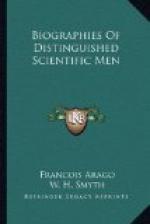The luminous shreds of the tail seemed to undergo rapid, frequent, and considerable variations of length. Herschel discerned symptoms of a movement of rotation both in the comet and in its tail. This rotatory motion carried unequal shreds from the centre towards the border, and reciprocally. On looking from time to time at the same region of the tail, at the border, for example, sensible changes of length must have been perceptible, which however had no reality in them. Herschel thought, as I have already said, that the beautiful comet of 1811, and that of 1807, were self-luminous. The second comet of 1811 appeared to him to shine only by borrowed light. It must be acknowledged that these conjectures did not rest on any thing demonstrative.
In attentively comparing the comet of 1807 with the beautiful comet of 1811, relative to the changes of distance from the sun, and the modifications resulting thence, Herschel put it beyond doubt that these modifications have something individual in them, something relative to a special state of the nebulous matter. On one celestial body the changes of distance produce an enormous effect, on another the modifications are insignificant.
OPTICAL LABOURS.
I shall say very little on the discoveries that Herschel made in physics. In short, everybody knows them. They have been inserted into special treatises, into elementary works, into verbal instruction; they must be considered as the starting-point of a multitude of important labours with which the sciences have been enriched during several years.
The chief of these is that of the dark radiating heat which is found mixed with light.
In studying the phenomena, no longer with the eye, like Newton, but with a thermometer, Herschel discovered that the solar spectrum is prolonged on the red side far beyond the visible limits. The thermometer sometimes rose higher in that dark region, than in the midst of brilliant zones. The light of the sun then, contains, besides the coloured rays so well characterized by Newton, some invisible rays, still less refrangible than the red, and whose warming power is very considerable. A world of discoveries has arisen from this fundamental fact.
The dark heat emanating from terrestrial objects more or less heated, became also subjects of Herschel’s investigations. His work contained the germs of a good number of beautiful experiments since erected upon it in our own day.
By successively placing the same objects in all parts of the solar spectrum Herschel determined the illuminating powers of the various prismatic rays. The general result of these experiments may be thus enunciated:
The illuminating power of the red rays is not very great; that of the orange rays surpasses it, and is in its turn surpassed by the power of the yellow rays. The maximum power of illumination is found between the brightest yellow and the palest green. The yellow and the green possess this power equally. A like assimilation may be laid down between the blue and the red. Finally, the power of illumination in the indigo rays, and above all in the violet, is very weak.




